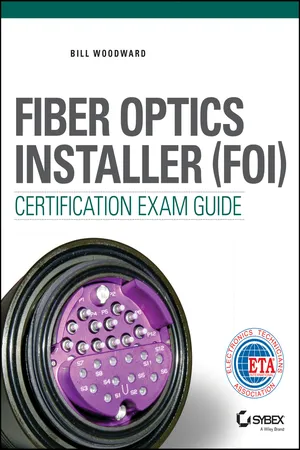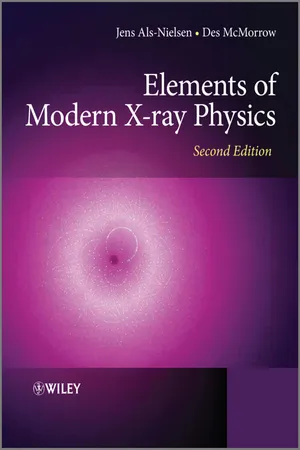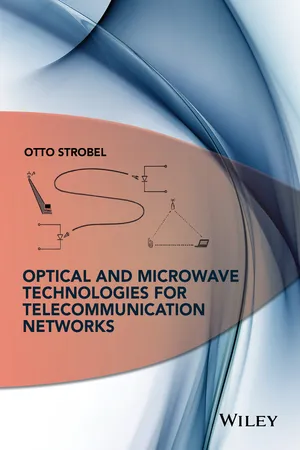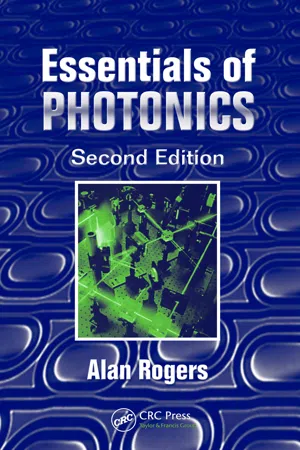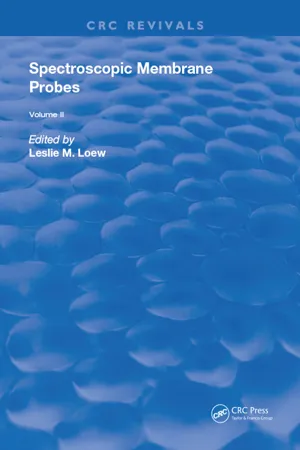Physics
Total Internal Reflection in Optical Fibre
Total internal reflection in optical fiber occurs when light traveling within the core of the fiber strikes the boundary with the cladding at an angle greater than the critical angle. This causes the light to be completely reflected back into the core, allowing it to propagate along the fiber with minimal loss. This phenomenon is essential for the transmission of light signals in optical communication systems.
Written by Perlego with AI-assistance
Related key terms
Related key terms
1 of 4
Related key terms
1 of 3
8 Key excerpts on "Total Internal Reflection in Optical Fibre"
- Bill Woodward(Author)
- 2014(Publication Date)
- Sybex(Publisher)
normal. Light traveling along the normal will change speed but will not change direction.Model used to calculate refractionFigure 3.10The angle of incidence represents the angle between the incident ray and normal. The angle of refraction represents the angle between the refracted ray and normal. Note that a small amount of light is also reflected from the interface at an angle equal to the angle of incidence.Total Internal Reflection
As shown in Figure 3.10 , light passing from a lower index of refraction to a higher index of refraction refracts toward normal. This is illustrated by the angle of refraction ( θ 2 ), which is smaller, then the angle of incidence (θ 1 ). When light passes from a higher index of refraction to a lower index of refraction, as shown in Figure 3.11 , the light refracts away from normal.We can calculate the amount of refraction using Snell's law, which shows the relationship between incident light and refracted lightLight passing from higher index of refraction to lower index of refraction refracts away from normal.Figure 3.11- n1 sinθ 1 = n2 sinθ 2
where n1 and n2 are the index of refraction values of each material, θ 1 is the angle of incidence, and θ 2 is the angle of refraction.Recall that the phenomenon that makes fiber-optic transmission possible, total internal reflection (TIR), is caused by the same principles that cause refraction. In the case of TIR, the light is passing from a higher index of refraction to a lower index of refraction at an angle that causes all of the light to be reflected. What has happened is that the angle of refraction has exceeded 90° from normal.The incident angle required to produce a refracted angle of 90° is called the critical angle. As the incident ray moves from normal toward the critical angle, less and less of the incident ray's energy is carried into the refracted ray. At the critical angle all of the incident ray's energy is refracted along the interface. As the incident angle exceeds 90°, the light is reflected, as shown in Figure 3.12- eBook - ePub
- Galen C. Duree(Author)
- 2011(Publication Date)
- For Dummies(Publisher)
Frustrated total internal reflection: Dealing with the evanescent wave(contain real and imaginary parts). When this increase happens, the magnitude is still 1, indicating that all light incident on a surface undergoing internal reflection is totally internally reflected — no light goes through to the other material. This major phenomenon is used with fiber optics, which I talk about in more detail in Chapter 16.In the preceding section, I mention that no light enters the second material as long as the incident light has an angle of incidence greater than the critical angle. However, if you look very close to the surface where the light hits, you find a small, exponentially decaying wave in the second material. If you place another material close to, but not touching, the first boundary, the second material can pick up and propagate the wave away. This wave that passes into the second material is called anevanescent wave.If this evanescent wave is intercepted with a high-index material before its amplitude is zero, the wave continues on in a process called frustrated total internal reflection.(No, that’s not what you do during a midlife crisis.) The energy from this wave comes from the incident wave, so when total internal reflection is frustrated, the energy in the reflected beam decreases by the amount carried away in the evanescent wave. If the process isn’t frustrated, the energy returns to the reflected beam so that the reflected beam experiences no energy loss.The fiber-optics industry uses the phenomenon of frustrated total internal reflection quite a bit to control the amount of light in different parts of the fiber network (head to Chapter 16 for more information about this application). This phenomenon is also used in devices called - Pascal Richet, Pascal Richet(Authors)
- 2021(Publication Date)
- Wiley-American Ceramic Society(Publisher)
Figure 4 .(a) Total internal reflection, single/multi/and GI fiber designs, (b) electromagnetic modes, and (c) schematic designs of photonic crystal fiber and MOF.Figure 4Source: Reprinted with permission from [5 ].2.2.1 Conventional Core–Clad Optical Fibers
As noted above, in the ray‐optic view, optical fibers guide light via total internal reflection whereby the light is confined in the high‐index core, which is surrounded by a lower‐refractive index cladding. Under this condition, i.e. light incident from a high‐index region into a lower‐index region, Snell's law for light refraction is violated when the angle of incidence exceeds a critical angle (given by sin−1 (nclad /ncore ), where nclad is the refractive index of the clad and ncore is the refractive index of the core, and reflection, instead of refraction, occurs (Figure 4 a). The index difference between core and clad need not be large and actually is one of the design parameters that define the behavior of the resultant waveguide.For simple descriptions, the ray‐optic picture generally suffices. For more sophisticated designs, however, light is more correctly described as a wave, and the aforementioned ray‐optic construction is replaced with a wave‐optic formalism in which electromagnetic modes are confined and allowed to propagate within a higher refractive index core coaxially surrounded by a lower‐refractive index cladding. In the wave‐optic perspective, the transverse components of the light waves constructively and destructively interfere across the core, influenced by the cladding, yielding stable propagating fiber modes. Some of the light power inevitably extends into the cladding: this component is called the evanescent field. The exact distribution of these modes depends on the core size, refractive index contrast between core and clad (defined by the numerical aperture, NA = [ncore 2 − nclad 2 ]1/2 ), the wavelength of light, and the cross‐sectional geometry of the core; i.e. whether rectangular, circular, elliptical, etc. Thorough reviews of conventional core/clad optical fiber designs are given in [5 , 11- eBook - ePub
- Jens Als-Nielsen, Des McMorrow(Authors)
- 2011(Publication Date)
- Wiley(Publisher)
Chapter 3 Refraction and reflection from interfacesA ray of light propagating in air changes direction when it enters glass, water or other transparent materials. This is the basis for the classical optics of lenses. Quantitatively, the phenomenon is described by Snell’s law. For visible wavelengths the refractive index n of most transparent materials has a value in the range between 1.2 and 2. The refractive index depends on the frequency ω of the light, so that blue light is refracted more than red light, etc.The index of refraction for electromagnetic waves displays resonant behaviour at frequencies corresponding to electronic transitions in atoms and molecules. On the low frequency side of a resonance, n increases with ω, and this is known as normal dispersion. Immediately above the resonance frequency it decreases, and as more and more resonances are passed, the magnitude of the index of refraction decreases. X-ray frequencies are usually higher than all transition frequencies, perhaps with the exception of those involving the inner K- or maybe L-shell electrons. As a result in the X-ray region n turns out to be less than unity. (See Fig. 1.8 and accompanying discussion.) This reflects the phase shift of π in the Thomson scattering of X-rays, as we shall see. Moreover, it leads to the phenomenon of total external reflection from a flat, sharp interface: for incident glancing angles α below a certain critical angle αc the ray will no longer penetrate into the material but will be totally reflected from it. The deviation of n from unity is tiny, so the critical angle is small. The reader might wonder how n can be less than unity, since the velocity in the material is c /n , and this would seem to imply that the speed of light is higher in the material than in vacuum. However, c /n is the phase velocity, not the group velocity. The latter, evaluated as d ω/d k, is indeed less than c - Otto Strobel(Author)
- 2016(Publication Date)
- Wiley(Publisher)
3 ). In the sidewise coupling light into the middle slab of such a waveguide, there is no light transition to media 2 and 3, thus the wave is guided. This is true, assuming the light ray in media 1 does not run too steeply, that is it has been already sufficiently flat injected. Regarding the inclination angle, it follows from Snell's law of refraction that:(3.1)Total internal reflection again occurs at every further reflection at the interface to media 2 or 3 (Chapter 2.4). The light ray can no longer leave media 1, thus a waveguide is generated. Based on hitherto existing considerations, wave propagation in the light waveguide could be assumed as follows: All light rays may accept any angle, starting from the light ray along the optical axis to the cut-off angle of the total internal reflection of αG ≤ α ≤ 90°.However, it appears that the angles are not continuously represented between these limit values, but exclusively specific discrete angles are allowed. Thus, the corresponding light waves are capable of propagating. This phenomenon can be demonstrated by the aid of superposition of multi-reflected waves.Considering the wave in Figure 3.1 b, first in point A and then, after the double reflection in point B, it is obvious that the wave has covered a definite distance Δg between these both points. Referring to Eq. (2.23), this yields to an optical path difference which takes effect on the interference of the original wave with the twice reflected one. Moreover, phase shifts have to be taken into account regarding the reflection at a denser media. According to Eq. (2.17), this leads to constructive or destructive interference being dependent on the path difference. In the latter case, a transportation of light energy in the desired propagation direction is inhibited. Only definite optical path differences and consequently exclusively specific distance differences are permitted. The distance differences depend on the inclination angle α of the light rays. This again means that only waves having light rays with specific angles are capable of propagation. The residual waves in the waveguide which propagate corresponding to the allowed light paths are named modes. In this connection, it deals with properties in space, thus they are also named spatial or transversal modes- eBook - ePub
- Alan Rogers(Author)
- 2017(Publication Date)
- CRC Press(Publisher)
1 :n 0 sin ϑ 0 = n 1 sin ϑ 1where η 0 and n 1 are the refractive indices of air and the fibre core material, respectively. If the angle at which the ray then strikes the core/cladding boundary is ϑ T , then, for TIR, we must have sin ϑ T > n 2 /n 1 where n 2 is the cladding index.Because, the inequality is equivalent toϑ T=1 2π -ϑ 1cosso from the Snell’s law expression above,ϑ 1>n 2n 1cosorϑ 1= ( 1 -n 0 2sin 2ϑ 0n 1 2)1 / 2n 0sinϑ 0< (n 1 2-n 2 2)1 / 2The quantity on the RHS of this inequality is known as the numerical aperture (NA) of the fibre. It is a specification of the ‘acceptance’ cone of light, this being a cone of apex half-angle ϑ 0 . Clearly, a large refractive index difference between core and cladding is necessary for a large acceptance angle; for a typical fibre, ϑ 0 ~ 10°.The discrete values of reflection angle which are allowed by the transverse resonance condition (within the TIR condition) can be represented by the ray propagations shown in Figure 8.10 b. This makes clear that for a large number of allowable rays (i.e., modes), the TIR angle should be large, implying a large NA. However, it is also clear, geometrically, that the rays will progress down the guide at velocities that depend on their angles of reflection: the smaller the angle, the smaller the velocity. This leads to large ‘modal dispersion’ at large NA because, if the launched light energy is distributed among many modes, the differing velocities will lead to varying times of arrival of the energy components at the far end of the fibre. This is undesirable in, for example, communications applications, because it will lead to a limitation on the communications bandwidth. In a digital system, a pulse cannot be allowed to spread into the pulses before or after it. For greatest bandwidth, only one mode should be allowed, and this requires a small NA. Thus, a balance must be struck between good signal level (large NA) and large signal bandwidth (small NA). We shall return to this topic in Section 8.6 - eBook - ePub
- Jerry Marion(Author)
- 2012(Publication Date)
- Academic Press(Publisher)
degree of polarization may be defined asFIG. 6-5(6.34)so that P (00 ) = P (900 ) = 0 and P (θB ) = 1; P (θ0 ) < 0 except for normal and for grazing incidence.6.4 Total Internal Reflection
An interesting application of the Fresnel equations is to consider the electromagnetic wave to be incident on the boundary surface from the more dense of the two media; i.e., we have n 1 < n 2 . If we start with θ0 = 0 and allow the angle of incidence to increase, all goes well until we reach an angle such that θ2 = π/2. From Snell’s law this occurs when sin θ0 = n 2 /n 1 , and the angle is called the critical angle :(6.35)We may write the cosine of the angle of refraction as(6.36)so that cos θ2 = 0 for θ0 = θc , but as θ0 is increased beyond θC , cos θ2 becomes a pure imaginary number. Therefore we write(6.37a)where Q is defined as the positive square root(6.37b)In order to determine the effect on the field in Medium 2 when the angle of incidence exceeds the critical angle, we write E 2 as [see Eq. (6.16) ](6.38)If we take the coordinate axes as in Fig. 6-2 , this becomes(6.39)But(6.40)where W is a real number, greater than unity. Thus, using Eqs. (6.37a) for cos θ2 , we have(6.41)We therefore see that for θ0 < θc , the wave is propagated along the surface and is attenuated in the direction into the medium. The phase velocity of the surface wave is(6.42)which is a function of the angle of incidence θ0 . We see that in the event Medium 2 is air (n2 = 1), the phase velocity is justV1 = c/n1 for grazing incidence.The amplitudes of the reflected electric vectors may be calculated from Fresnel’s equations [Eqs. (6.25a) and (6.28a) ]. For the case of E - eBook - ePub
Spectroscopic Membrane Probes
Volume 2
- Leslie M. Loew(Author)
- 2018(Publication Date)
- CRC Press(Publisher)
M sodium dithionite, among other substances.FIGURE 6. TIR illumination through the periphery of a high-aperture objective. We have successfully tried this method with a Zeiss® 63 ×, N.A. = 1.4, oil immersion objective, but the sample region illuminated by TIR covers only a fairly small area near the center of the field of view. The vertical scale here is somewhat stretched for clarity. Incidence angle θ will be greater than critical angle θC only for extreme peripheral rays.III. EXCITATION OF FLUOROPHORES BY TIR A. Single InterfaceWhen a light beam propagating through a transparent medium 3 of high index of refraction (e.g., a solid-glass prism) encounters an interface with a medium 1 of a lower index of refraction (e.g., an aqueous solution), it undergoes total internal reflection for incidence angles (measured from the normal to the interface) greater than the “critical angle”. The critical angle θC , is given by:θ c=sin(− 1n 1/n 3)=sin− 1(∈ 1/∈ 3)1 / 2(1) where n1 and n3 are the refractive indexes of the liquid and the solid, respectively, and ∈1 , and ∈3 are the corresponding dielectric constants. Although the incident light beam totally internally reflects at the interface, an electromagnetic field called the “evanescent wave” penetrates a small distance into the liquid medium and propagates parallel to the surface in the plane of incidence. The evanescent wave is capable of exciting fluorescent molecules that might be present near the interface.The evanescent electric-field intensity I(z) decays exponentially with perpendicular distance z from the interface:
where:I(z) =I(0)e− z/d(2) d =λ 04 π[∈ 3sin 2θ −∈ 1]− 1 / 2(3) for angles of incidence θ; > θc and light wavelength in vacuum λ0 . Depth d is independent of the polarization of the incident light and decreases with increasing θ. Except for θ ≃ θc (where d →∞), d is on the order of λ0
Index pages curate the most relevant extracts from our library of academic textbooks. They’ve been created using an in-house natural language model (NLM), each adding context and meaning to key research topics.
Explore more topic indexes
Explore more topic indexes
1 of 6
Explore more topic indexes
1 of 4
